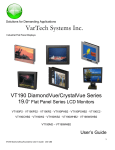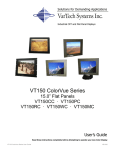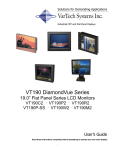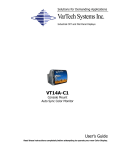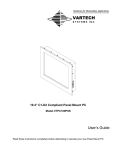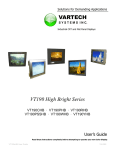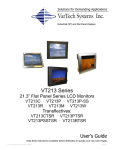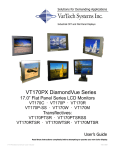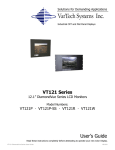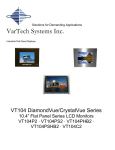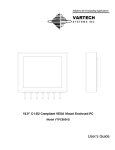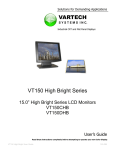Download VarTech Systems VT190R User`s guide
Transcript
Solutions for Demanding Applications VarTech Systems Inc. Industrial CRT and Flat Panel Displays VT190 ColorVue Series 19.0” Flat Panel Series LCD Monitors VT190PC VT190RC User’s Guide Read these instructions completely before attempting to operate your new Color Display. VT190 ColorVue User Guide 150-077 Table Of Contents Section Page Section Page Section 1 Section 5 Introduction Touch screen 14 1.1 About LCD Monitors 1 5.1 Introduction 14 1.2 Product Safety Precautions 2 5.2 Installation 14 Section 2 Section 6 Display Setup Troubleshooting Tips 2.1 Display Features 3 2.2 Unpacking The Display 4 Section 7 2.3 Included Parts 4 Cleaning & Maintenance 2.4 Connecting Your Display 4 2.5 Signal Connections 4-6 15 16 Section 8 Mechanical Drawings 17 Section 3 Panel Mount Mechanical Drawings 18-19 Getting Started Rack Mount Mechanical Drawings 20 3.1 Adjusting the Display 7 3.2 Control Panel Functions 7 3.3 OSD Adjustment 8-12 Section 4 Display Timing 13 Section 9 Display Specifications 21 Section 1 1.1 INTRODUCTION About LCD Monitors What you gain by using an LCD monitor in your industrial controls LCDs are the future of display technology. Although CRTS have dropped in cost significantly, they do not offer the performance, reliability, and mounting options available with LCDs. LCD monitors consist primarily of an LCD, Video Board and a Back Light video. The LCD determines to a large extent the viewing angle, brightness and contrast. Beyond that it is the function of the video board which converts the analog RGB (Red, Green, Blue) signals from a standard video card to a high quality, digital RGB that the LCD can display. Recently the video card has taken on a new role. It is the responsibility of this device to “scale” a particular video resolution to the “native” resolution of the LCD. Simply, consider that a computer is putting out a VGA [640x480] resolution signal, yet the LCD that is connected is an XGA [1024x768] display. The displayed picture would be in the center 1/3 of the LCD. With the introduction of the scaling engine. The converter will mathematically recalculate the 640x480 to 1024x768. This may sound simple but it is in fact a complex algorithm that adjusts for different aspect ratios and pixel alignment, essentially smoothing text and graphics to produce a picture that is pleasant to the eye. All Vartech displays from 12.1” (800x600) to 23.1 (1600x1200) incorporate scaling engines in the converter card. 1 VT190 ColorVue User Guide 150-077 1.1 Product Safety Precautions ⇒ Ensure that sufficient space is available around the display to provide the circulation necessary for cooling. ⇒ Ensure that the ambient air temperature will not exceed the specified maximum temperature. ⇒ Do not attempt to service this display yourself. The rear chassis has a seal so that non qualified personal will not expose themselves to dangerous voltages or other risks. ⇒ To protect from electrical shock, unplug the display power supply from the wall before moving. ⇒ Do not expose the display to direct sunlight or heat. ⇒ Do not use this display near water ⇒ Do not place any heavy objects on the power cords. Damage may cause electrical shock. ⇒ Unplug the power supply from the wall or unit if one of the following conditions exists. ⇒ Power cord or plug is damaged or frayed ⇒ Liquid is spilled into the display or the display is exposed to rain or water. ⇒ The display does not operate normally when the operating instructions are followed. ⇒ The display has been dropped or the enclosure has been damaged. ⇒ The display exhibits a distinct change in performance, indicating a need for service. 2 Section DISPLAY SETUP 2 2.1 VT190 ColorVue Series Display Features ⇒ Capable of displaying unlimited colors in a continuous spectrum. The high contrast LCD enhances the image with no geometric distortion. ⇒ The VT190 ColorVue Series directly accepts an analog 5 wire RGB with separate H/V sync. ⇒ The VT190 ColorVue Series is auto synchronous adjusting the display to the appropriate input between VGA, SVGA,XGA, and SXGA. ⇒ The VT190 ColorVue Series is available in Panel Mount, Rack Mount, or Wall Mount industrial packages. ⇒ The VT190 ColorVue Series is supplied with a Anti-Reflective Screen unless equipped with an optional Touch System. ⇒ The VT190 ColorVue Series has an integrated 115/220VAC supply as standard on all models. 3 VT190 ColorVue User Guide 150-077 2.2 Unpacking and setting up your display Your LCD monitor package will consist of the components listed below. Open shipping container and lay all components on a flat clean surface. 2.3 What is included with your display ⇒ ⇒ ⇒ ⇒ ⇒ ⇒ VT190RC or VT190PC LCD Monitor 5 ft Video Cable 10-32 Mounting Hardware. (For use with Panel Mount only) 6 ft RS232 Touch Interface Cable (Optional when touch is installed) CD ROM with Touch Screen Drivers (Optional when touch is installed) Users Guide (Printed or on CD) 2.4 Connecting the Display 1. Connect all cables to the computer first. This would include the VGA cable and the optional RS 232 serial touch screen connection. 2. After connecting the cables between the LCD monitor and the computer, plug the power cord into the 115/220VAC power outlet. 3. Once the 115/220VAC connection is made, the display is active. 4. If your computer was off, turn on your computer. 5. Your display should now operate as a normal computer display showing your windows or whatever video is being sent to the flat panel. Note: If for any reason the display goes blank and gives an “out of Range” or “No Input Signal”, your computer or video source is putting out a signal that is out of range of the LCD’s video board. If this happens, reboot the computer or video source and make sure you are inputting the correct signal. If the display doesn’t work properly, it may be because: (a) The resolution is to high or low for the LCD. (b) The refresh rate is set to high. Refresh on an LCD is different than a CRT. Set the refresh to 60Hz. CRT’s need a high refresh rate to avoid flicker. The refresh rate has no impact on LCD’s. (c) The power source is incorrect. (d) The unit is malfunctioning. If you believe this to be true, disconnect the video cable from the rear of the LCD and connect to a known good computer CRT display. If the computer display is working satisfactory and the video is within the appropriate range, then contact Vartech Customer service for a RMA number at 800-223-8050. 2.5 Signal Connections To avoid irregular operation and /or damage to the display, please insure correct video is being supplied as shown on the following page. 4 2.5 Signal Connections Cont. You can use an HD-15 connector cable or a BNC adapter cable to connect the flat panel monitor to the host computer. The HD-15 video cable (supplied in the kit) you use with this monitor is equipped with a conventional HD-15 connector at each end. Note: The following figure is the view looking into the pin end of the male connector or solder term end of the female connector. HD-15 Video Connector The following table provides the pin numbers and corresponding pin assignments for the HD-15 video connector. Pin Signal (HD15) Pin Signal (HD15) Pin Signal (HD15) 1 Red Video 6 Red Video Ground 11 Monitor Ground 2 Green Video 7 Green Video Ground 12 DDC data 3 Blue Video 8 Blue Video Ground 13 Horizontal Sync 4 Not Used 9 +5 V 14 Vertical Sync 5 Ground 10 PC detection 15 DDC clock DVI-I Connector (Digital / Analog) C2 C1 C5 1 8 9 16 24 17 Pin Signal (DVI-I) C3 C4 Pin Signal (DVI-I) Pin Signal (DVI-I) C1 Not Used C2 Not Used C3 Not Used C4 Not Used C5 Not Used Pin Signal (DVI-I) 1 T.M.D.S. Data2- 9 T.M.D.S. Data1- 17 T.M.D.S. Data0- 2 T.M.D.S. Data2+ 10 T.M.D.S. Data1+ 18 T.M.D.S. Data0+ 3 SGND 11 SGND 19 SGND 4 Not used 12 Not used 20 Not used 5 Not used 13 Not used 21 Not used 6 DDC Clock 14 DDC Power 22 SGND 7 DDC Data 15 Ground 23 T.M.D.S. Clock+ 8 Not used 16 Hot Plug Detect 24 T.M.D.S. Clock- 5 VT190 ColorVue User Guide 150-077 2.5 Signal Connections Cont. Optional BNC Adaptor Cable An HD-15 to 5-BNC adapter cable is available. The functions of the cables are described below. ⇒ R, B, and G: Red, Green, and Blue input connectors to establish color. These are used for RS-343 analog signals. ⇒ HS: Separate horizontal sync signal from the video source. ⇒ VS: Separate vertical sync signal from the video source. 6 Section 3 3.1 Getting Started Adjusting the display The VT190 Series display has an embedded microprocessor in the converter card. Once you have the unit displaying the resolution you desire for your application do the following: In order to navigate to the appropriate adjustments, press Menu and the OSD layout chart will appear as indicated in Fig. 1 from left to right. If you press the “MENU” the new settings are saved and the OSM appear and your setting will be stored in the unit’s non volatile memory. 1 3.2 2 3 4 Control Panel Functions Control 1 Function Use this button to turn the monitor on and off. POWER 2 MENU Use this button to enter or exit the On Screen Display. 3 SEL Use this button to enter a selection in the On Screen Display. Use these button to choose or adjust items in the On Screen Display. 4 7 VT190 ColorVue User Guide 150-077 3.3 On Screen Display (OSD) Control Adjustment Screen Adjustment Operation Procedure 1) Entering the Screen Adjustment The setting switches are normally at stand-by. Push the MENU button once to display the main menu of the screen adjustment. The adjustable items will be displayed in the main menu. 2) Entering the Settings Use the Adjust ▼and Adjust ▲buttons to select the desired setting icon and push the SELECT button to enter sub-menu. 3) Change the Settings After the sub-menu appears, use the Adjust ▼and Adjust ▲buttons to change the setting values. 4) Save After completing the adjustment, push the SELECT button to save the setting. 5) Return & Exit the Main Menu Exit the screen adjustment, push the ‘SELECT’ button and the ‘EXIT’ of “MISC MENU”. When no operation is done around 60 sec (default OSD timeout), it goes back t the stand-by mode and no more switching is accepted except MENU to restart the setting. 8 3.3 On Screen Display (OSD) Control Adjustment Cont. The following table indicates all the On Screen Display control, adjustment, and setting menus. Main Menu Sub Menu BRIGHTNESS BRIGHTNESS CONTRAST CONTRAST COLOR PRESET A D Reference To adjust the brightness and contrast of the screen To customize the color of the screen 9300K 6500K R/G/B (User Color) POSITION To adjust the position of the screen V POSITION H POSITION TRACKING CLOCK To improve the clarity and stability of the screen PHASE SETUP AUTO CONFIG To customize the screen status for a user’s operating environment INPUT INFORMATION RECALL AUDIO OSD ADJUST EXIT To Exit the OSD EXIT Legend : Adjustable A: Analog Input D-SUB D: Digital Input DVI-D 9 VT190 ColorVue User Guide 150-077 3.3 On Screen Display (OSD) Control Adjustment Cont. The OSD main menu is displayed on screen when MENU key is pressed. The OSD menu is a combination of graphic and text display. The first line always shows the current selected or active menu item. The bottom line of main menu shows information of the input image. The UP and DOWN keys are used to scroll through items within the menu. The selected item is highlighted as the scrolling move along. The SELECT key is used to activate the highlighted item. During this state, the MENU key is used to close the OSD menu from the screen. 1024x768 70Hz OSD - On Screen Display Icon Function Description BRIGHTNESS Adjusts the brightness of the screen. CONTRAST Adjusts the contrast of the screen. COLOR 9300K / 6500K PRESET • • • RED (user mode) Adjusts the gain of red channel in ADC. GREEN (user mode) Adjusts the gain of green channel in ADC. BLUE (user mode) Adjusts the gain of blue channel in ADC. VERTICAL POSITION Moves the image up and down. 9300K: Default to 9300K color temp 6500K: Default to 6500K color temp User Mode: Used to adjust RGB HORIZONTAL POSITION Moves the image left and right. INPUT Selects the applicable input source, analog input (D-SUB), or Digital input (DVI-D) INFORMATION Provides the user with detailed information regarding the current input format and version. 10 3.3 On Screen Display (OSD) Control Adjustment Cont. OSD - On Screen Display Icon Function Description Adjusts the number pixels per line CLOCK Adjusts the ADC pixel clock PHASE AUTO CONFIG D-SUB Input source only Auto Adjust Auto Tracking Use the ▲and ▼buttons to scroll up and down in the menu, then press the SELECT key to start this function. If the MENU key is pressed, the main menu is re-displayed and nothing is changed. Performs automatic configuration of the phase, clock, vertical position and horizontal position. Tunes the clock and phase to the best condition automatically. Centers the image automatically. Both Auto Position horizontal and vertical position are adjusted so that the image is centered on the display. Adjusts the gain and offset of the RED, Auto Color GREEN and BLUE channels on the ADC automatically. Return Goes back to main menu. How to use the AUTO CONFIG Adjustment This function tunes the parameters of PHASE, CLOCK, H-POSITION, and V-POSITION. Suggested steps for Auto Config Adjustment: 1) Enter the “Windows” Shut-down frame. Note: The Wallpaper color CAN NOT be black. 2) Enter OSD Main menu and choose the AUTO CONFIG item, then press the SELECT key. The picture will auto-adjust by itself. After 4 seconds, you can exit OSD and Shut-down frame. 3) If you are not still satisfied with the picture quality, you could choose CONTRAST item in OSD Main Menu and adjust it. 11 VT190 ColorVue User Guide 150-077 3.3 On Screen Display (OSD) Control Adjustment Cont. OSD - On Screen Display Icon Function Description Adjusts miscellaneous OSD settings OSD ADJUST Used to setup the OSD menu position. The item “OSD POSITION” is used to setup the OSD menu position. The OSD menu horizontal and vertical position is adjusted separately. OSD Position Each position adjustment item will bring up the slider window. The maximum value of the sliders are based on the size do the OSD menu. Black Level Adjust Used to adjust the black level (zero level offset) of the AD converters. Language Used to select the OSD menu in 5 languages: English, German, French, Italian, Spanish Sharpness This can adjust the video quality to be sharp or blur. Currently Not Available AUDIO ADJUST Volume Increases and decreases the volume. Mutes the audio. Balance Adjusts the proportion of sound coming from each speaker. Bass Adjusts the low (bass) frequency audio output. Treble Adjusts the high (treble) frequency audio output. Mute Temporarily silences audio output. RECALL Reloads all factory default parameters. Note: If you don’t press any keys during 45 seconds, the OSD will disappear by itself and not save the parameters. 12 Section 4 Display Timing Applicable Video Timing The following table lists the better display quality modes that these LCD monitors provide. If the other video modes are input, the monitor will stop working or display unsatisfactory picture quality. VESA MODES Horizontal Vertical VCLK Mode Resolution Total Nominal Frequency +/- 0.5KHz Nominal Frequency +/- 1KHz Nominal Pixel Clock (MHz) DOS 720 x 400 @ 70Hz 900 x 449 31.469 70.087 28.322 VGA 640 x 480 @ 60Hz 800 x 525 31.469 59.940 25.175 640 x 480 @ 72Hz 832 x 520 37.861 72.809 31.500 640 x 480 @ 75Hz 840 x 500 37.500 75.000 31.500 800 X 600 @ 56Hz 1024 x 625 35.156 56.250 36.000 800 X 600 @ 60Hz 1056 x 628 37.879 60.017 40.000 800 X 600 @ 72Hz 1040 x 666 48.077 72.188 50.000 800 X 600 @ 75Hz 1056 x 625 46.875 75.000 49.500 1024 x 768 @ 60Hz 1344 x 804 48.363 60.004 65.000 1024 x 768 @ 70Hz 1328 x 806 56.476 70.069 75.000 1024 x 768 @ 75Hz 1312 x 800 60.023 75.029 78.750 1152 x 864 @ 75Hz 1600 x 900 67.500 75.000 108.00 1280 x 1024 @ 60Hz 1688 x 1066 63.981 60.020 180.00 SVGA XGA SXGA IBM MODES EGA 640 x 350 @ 70Hz 800 x 449 31.469 70.086 25.175 DOS 720 x 400 @ 70Hz 900 x 449 31.469 70.087 28.322 VGA 640 x 480 @ 60Hz 800 x 525 31.469 59.940 25.175 XGA 1024 x 768 @ 72Hz 57.515 72.100 75.000 MAC MODES VGA 640 x 480 @ 60hz 800 x 525 31.469 59.940 25.175 SVGA 832 x 624 @ 75Hz 1152 x 667 49.725 74.551 57.283 XGA 1024 x 768 @ 75Hz 1328 x 804 60.241 74.927 80.000 13 VT190 ColorVue User Guide 150-077 Section 5 5.1 Touch Screen Introduction Touch screens are a common means to interface operator inputs to a system. The universal standard of Windows GUI (Graphical User Interface) has significantly increased the use of touch screens. There are four main touch technologies. The technologies are resistive, surface acoustic wave (SAW), capacitive, and infrared (IR). Each touch technology has advantages and disadvantages based on different user applications. 5.2 Installation All Vartech Systems displays configured with a touch screen are supplied with a CDROM which includes user manuals, application software, and drivers for various operating systems. Insert the supplied CDROM into a CDROM drive and follow the installation instructions that will appear on the screen. Limited technical support is available by contacting Vartech Systems customer support at 800-223-8050. 14 Section 6 Troubleshooting Problem Troubleshooting Tip No image on display screen 1) Check that the power cord of the Computer has been connected securely into wall outlet or grounded extension cable or strip. 2) Check that the power switch of the Display has been pressed and the LED on the front of the Display is lit. 3) Check that the Video (Signal) Cable from the Display has been securely and correctly connected. 4) Check that the Video Card is firmly seated in card slot of Computer motherboard. 5) Check that the Video Input from the Video Card falls within the timing range of the Display. (see Display Timing - Section 4) Abnormal image 1) Check that the Video Input from the Video Card falls within the timing range of the Display. (see Display Timing - Section 4) 2) Check that the Video (Signal) Cable from the Display has been securely and correctly connected to the Video Connector at the rear side of the Computer. Colors of image on screen are abnormal 1) Check that the Video (Signal) Cable from the Display has been securely and correctly connected to the 15Pin Video Connector at the rear of the computer. Disturbances on Screen 1) OSD adjustment is incorrect. (See OSD screen adjustment procedures Section 3) 15 VT190 ColorVue User Guide 150-077 Section 7 Cleaning and Maintenance Cleaning Occasionally clean the display panel and cabinet with a soft cloth dampened (not soaked) with a mild (non-abrasive) glass cleaner. Keep turning a fresh side of the cloth toward the screen surface to avoid scratching it with accumulated grit. Note: The solvent (a 50/50 mixture isopropyl alcohol and water) should be applied only to the cloth, and not directly on the monitor screen. Do not use paper products as they may scratch the surface. To minimize the risk of abrasion, allow the screen to stand dry. Special care should be taken when cleaning a touch screen or polycarbonate shield that is installed over the screen. Abrasive and certain chemical cleaners can easily damage the surface. Never use alcoholic or ammoniac cleaners to clean the polycarbonate shield or a touch screen. Replacing a Line Cord To avoid shock and fire hazards, the monitor’s power cord should be replaced if the insulation becomes broken or if it develops a loose internal connection. Other Maintenance Qualified service personnel should perform all maintenance, except for the power cord replacement described above. 16 Section 8 Mechanical Drawings Mechanical Drawings 7.1 Model Description Page(s) VT190PC 19.0” ColorVue Panel Mount Mechanical Drawing 18-19 VT190RC 19.0” ColorVue Rack Mount Mechanical Drawing 20 Panel Mount Procedure Panel Mounting Procedure 1. Cut and drill the panel (refer to panel mount drawing). Measurements are in inches. Panel Mounting Cutout 2. If access to the side of the monitor is not available following installation, attach the power and video cables to the side of the monitor at this time. 3. Install the monitor in the prepared cutout. 4. Install the lock nuts and washers, supplied with the monitor, behind the holes running along the sides and top/bottom of the cutout in the panel. Extra lock nuts and washers are provided. Note: Use #10-32 nuts for mounting. 5. Tighten all mounting nuts evenly to a torque of 24 inch-pounds. ATTENTION: Mounting nuts must be tightened to a torque of 24 inch-pounds to provide panel seal and avoid potential damage. Vartech Systems assumes no responsibility for water or chemical damage to the monitor or other equipment within the enclosure due to improper installation. 6. Attach the power and video cables to the side of the monitor if you have not already done so. 17 VT190 ColorVue User Guide 150-077 Section 9 Specifications Panel Size Type Pixel Pitch Resolution Active Diagonal Active Screen Area 19.0” TFT Active matrix w/ Anti-Glare coating 0.297mm SXGA 1280 x 1024 max 19.0” Viewable 14.8” x 11.85” 376mm x 301mm Pixel Format 640 x 480, 800 x 600, 1024 x 768, 1280 x 1024 Viewing Angle (Up/Down) 85/85 deg. Viewing Angle (Left/Right) 85/85 deg. Contrast Ratio 500:1 Brightness 250 Nits Response Time TR = 15ms TD = 10ms Back Lights Cold Cathode 50,000 Hrs. Half Life Video Connectors HD15(F) DVI-I 29Pin connector (Digital/Analog) Video Input RGB Analog (0.7V p-p / 75ohm), Digital Sync TTL level, Positive/Negative, Separate H&V Horizontal Sync 30-82kHz Vertical Sync 56-75Hz Colors Supported 16.7M Power Input AC 100-240V 50/60Hz 1.0A Power consumption 70 Watts @ 115VAC Operating Temperature 0 to 50ºC Storage Temperature -20 to 60ºC Operating Humidity 10 to 95% NC Storage Humidity 5 to 95% NC Operating Altitude Up to 10,000 ft Storage Altitude Up to 50,000 ft 21 VARTECH SYSTEMS INC. HEADQUARTERS 11529 Sun Belt Ct. Baton Rouge, Louisiana 70809 Toll-Free: 800.223.8050 International Phone: 001.225.298.0300 Fax: 225.297.2440 E-mail: [email protected] www.vartechsystems.com 150-077-001 8.27.04 VT190 ColorVue User Guide 150-077





















